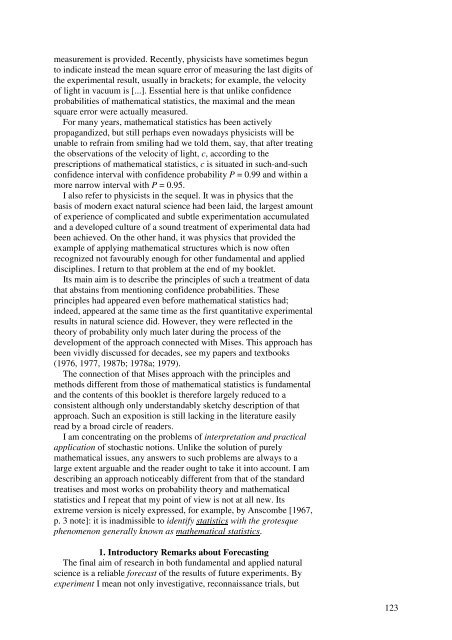1 Studies in the History of Statistics and Probability ... - Sheynin, Oscar
1 Studies in the History of Statistics and Probability ... - Sheynin, Oscar
1 Studies in the History of Statistics and Probability ... - Sheynin, Oscar
You also want an ePaper? Increase the reach of your titles
YUMPU automatically turns print PDFs into web optimized ePapers that Google loves.
measurement is provided. Recently, physicists have sometimes begunto <strong>in</strong>dicate <strong>in</strong>stead <strong>the</strong> mean square error <strong>of</strong> measur<strong>in</strong>g <strong>the</strong> last digits <strong>of</strong><strong>the</strong> experimental result, usually <strong>in</strong> brackets; for example, <strong>the</strong> velocity<strong>of</strong> light <strong>in</strong> vacuum is [...]. Essential here is that unlike confidenceprobabilities <strong>of</strong> ma<strong>the</strong>matical statistics, <strong>the</strong> maximal <strong>and</strong> <strong>the</strong> meansquare error were actually measured.For many years, ma<strong>the</strong>matical statistics has been activelypropag<strong>and</strong>ized, but still perhaps even nowadays physicists will beunable to refra<strong>in</strong> from smil<strong>in</strong>g had we told <strong>the</strong>m, say, that after treat<strong>in</strong>g<strong>the</strong> observations <strong>of</strong> <strong>the</strong> velocity <strong>of</strong> light, c, accord<strong>in</strong>g to <strong>the</strong>prescriptions <strong>of</strong> ma<strong>the</strong>matical statistics, c is situated <strong>in</strong> such-<strong>and</strong>-suchconfidence <strong>in</strong>terval with confidence probability P = 0.99 <strong>and</strong> with<strong>in</strong> amore narrow <strong>in</strong>terval with P = 0.95.I also refer to physicists <strong>in</strong> <strong>the</strong> sequel. It was <strong>in</strong> physics that <strong>the</strong>basis <strong>of</strong> modern exact natural science had been laid, <strong>the</strong> largest amount<strong>of</strong> experience <strong>of</strong> complicated <strong>and</strong> subtle experimentation accumulated<strong>and</strong> a developed culture <strong>of</strong> a sound treatment <strong>of</strong> experimental data hadbeen achieved. On <strong>the</strong> o<strong>the</strong>r h<strong>and</strong>, it was physics that provided <strong>the</strong>example <strong>of</strong> apply<strong>in</strong>g ma<strong>the</strong>matical structures which is now <strong>of</strong>tenrecognized not favourably enough for o<strong>the</strong>r fundamental <strong>and</strong> applieddiscipl<strong>in</strong>es. I return to that problem at <strong>the</strong> end <strong>of</strong> my booklet.Its ma<strong>in</strong> aim is to describe <strong>the</strong> pr<strong>in</strong>ciples <strong>of</strong> such a treatment <strong>of</strong> datathat absta<strong>in</strong>s from mention<strong>in</strong>g confidence probabilities. Thesepr<strong>in</strong>ciples had appeared even before ma<strong>the</strong>matical statistics had;<strong>in</strong>deed, appeared at <strong>the</strong> same time as <strong>the</strong> first quantitative experimentalresults <strong>in</strong> natural science did. However, <strong>the</strong>y were reflected <strong>in</strong> <strong>the</strong><strong>the</strong>ory <strong>of</strong> probability only much later dur<strong>in</strong>g <strong>the</strong> process <strong>of</strong> <strong>the</strong>development <strong>of</strong> <strong>the</strong> approach connected with Mises. This approach hasbeen vividly discussed for decades, see my papers <strong>and</strong> textbooks(1976, 1977, 1987b; 1978a; 1979).The connection <strong>of</strong> that Mises approach with <strong>the</strong> pr<strong>in</strong>ciples <strong>and</strong>methods different from those <strong>of</strong> ma<strong>the</strong>matical statistics is fundamental<strong>and</strong> <strong>the</strong> contents <strong>of</strong> this booklet is <strong>the</strong>refore largely reduced to aconsistent although only underst<strong>and</strong>ably sketchy description <strong>of</strong> thatapproach. Such an exposition is still lack<strong>in</strong>g <strong>in</strong> <strong>the</strong> literature easilyread by a broad circle <strong>of</strong> readers.I am concentrat<strong>in</strong>g on <strong>the</strong> problems <strong>of</strong> <strong>in</strong>terpretation <strong>and</strong> practicalapplication <strong>of</strong> stochastic notions. Unlike <strong>the</strong> solution <strong>of</strong> purelyma<strong>the</strong>matical issues, any answers to such problems are always to alarge extent arguable <strong>and</strong> <strong>the</strong> reader ought to take it <strong>in</strong>to account. I amdescrib<strong>in</strong>g an approach noticeably different from that <strong>of</strong> <strong>the</strong> st<strong>and</strong>ardtreatises <strong>and</strong> most works on probability <strong>the</strong>ory <strong>and</strong> ma<strong>the</strong>maticalstatistics <strong>and</strong> I repeat that my po<strong>in</strong>t <strong>of</strong> view is not at all new. Itsextreme version is nicely expressed, for example, by Anscombe [1967,p. 3 note]: it is <strong>in</strong>admissible to identify statistics with <strong>the</strong> grotesquephenomenon generally known as ma<strong>the</strong>matical statistics.1. Introductory Remarks about Forecast<strong>in</strong>gThe f<strong>in</strong>al aim <strong>of</strong> research <strong>in</strong> both fundamental <strong>and</strong> applied naturalscience is a reliable forecast <strong>of</strong> <strong>the</strong> results <strong>of</strong> future experiments. Byexperiment I mean not only <strong>in</strong>vestigative, reconnaissance trials, but123









